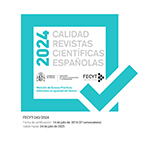El Trabajo Social relacional: una perspectiva para rastrear la configuración socioambiental del riesgo de inundación en los asentamientos precarios
Resumen
En la actualidad, las implicaciones y las consecuencias de las interacciones humanas en la sostenibilidad socioambiental y ecológica y en la construcción del riesgo son incontestables. Desde esta perspectiva, el Trabajo Social hoy tiene una oportunidad para recuperar las bases de su teoría social sobre la relación entre “la persona y su entorno” y aplicarlas a las interacciones socioambientales de las comunidades vulnerables, relativizando su papel en la configuración de los desastres por inundación en los asentamientos precarios. En este sentido, en este artículo presentamos una perspectiva relacional que indaga en las interacciones socioambientales de las poblaciones que migran por desplazamiento forzado, aplicando el análisis de redes sociales (ARS), para comprender la configuración socioambiental del riesgo de inundación en los asentamientos precarios, con la ilustración de un caso en Colombia. Nos encontramos con redes de migrantes que fundan asentamientos precarios en zonas de protección ambiental con una precaria percepción del riesgo –cuando hay desesperación, falta de oportunidades y de acceso a la tierra– para la construcción de viviendas, que conforma unos vínculos institucionales informales que sostienen el desarrollo del asentamiento con favores políticos. Reconocer la formación de estas redes es una oportunidad para reflexionar acerca de sus formas de pensar y de actuar, así como estas son una pieza importante de información para proponer escenarios de diálogo entre los actores implicados que, a su vez, facilite la definición de acuerdos colectivos que construyan ambientes más seguros y sostenibles.Descargas
Descarga artículo
Licencia
La revista Cuadernos de Trabajo Social, para fomentar el intercambio global del conocimiento, facilita el acceso sin restricciones a sus contenidos desde el momento de su publicación en la presente edición electrónica, y por eso es una revista de acceso abierto. Los originales publicados en esta revista son propiedad de la Universidad Complutense de Madrid y es obligatorio citar su procedencia en cualquier reproducción total o parcial. Todos los contenidos se distribuyen bajo una licencia de uso y distribución Creative Commons Reconocimiento 4.0 (CC BY 4.0). Esta circunstancia ha de hacerse constar expresamente de esta forma cuando sea necesario. Puede consultar la versión informativa y el texto legal de la licencia.









